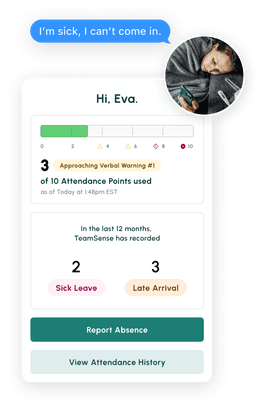When to HR with AI (and When Not To)!
Table of Contents
Effective communication, especially with frontline workers, is the lifeblood of any successful manufacturing organization. It plays a vital role in fostering a positive workplace culture, driving productivity, and ensuring smooth operations. While email has long been the go-to method for internal communications among desk employees in many companies, it does not cater to the unique needs of non-desk employees, such as the hourly manufacturing workforce.
These employees often lack a company email address but still require a means to contact their employer regarding absences, family and medical leave requests, and safety concerns. Moreover, production facilities need to be able to relay essential information to their employees quickly and effectively communicate in real-time without playing phone tag.
Email's limitations become particularly apparent when considering how best to reach these non-desk workers. Since they may not have regular access to a computer or company email account, important messages can go unread or unacknowledged, potentially creating barriers to effective communication. This highlights the need for alternative communication methods that are better suited to the unique circumstances of the manufacturing workforce.
Text messaging is one such method that offers a non-invasive way to reach employees, particularly when compared to using a company app. With the ubiquity of mobile phones, text messages can be sent and received instantly, ensuring that crucial information reaches workers in a timely manner. Furthermore, texting is a familiar and user-friendly method of communication that does not require employees to download and learn to navigate a new app, making it a more accessible and convenient option.
In this post, we will explore various alternatives to email communication, with a special focus on text messaging and its advantages in communicating and connecting with non-desk employees on the manufacturing floor. We will also discuss other communication strategies that can be employed to ensure that hourly manufacturing employees are well-informed and engaged in the workplace.
Unique Communication Challenges for Hourly Workers in Manufacturing
Hourly workers in manufacturing environments face several unique communication challenges due to the nature of their jobs and workplace settings. These challenges can create barriers to effective communication, which, if not addressed, may have negative consequences for both employees and the organization.
For instance, HR and supervisors often face communication challenges when trying to get in touch with hourly employees who are off the clock. One such challenge is finding a communication method that respects the employees' personal time while ensuring that important information is delivered promptly. Since hourly employees are not typically provided with a company email address, alternative communication channels need to be considered. Moreover, off-the-clock employees may be more reluctant to engage with company-related matters, making it harder to reach them during their personal time.
On the other hand, employees may also need to communicate with management to report an absence or other events that impact the entire production team. In these cases, it is essential to have an easy-to-use and accessible communication method in place that allows employees to quickly inform their supervisors about unforeseen circumstances or last-minute changes. This is particularly important in the manufacturing industry, where an absence or delay in communication can have significant consequences for production schedules, team coordination, and overall productivity.
Impact of Failed Communication
When communication breaks down in a manufacturing environment, it can have several detrimental effects:
- Reduced productivity: Miscommunication or lack of information can lead to mistakes, delays, and decreased efficiency, which can negatively impact overall productivity.
- Lower employee morale: Inadequate communication can leave employees feeling disconnected, undervalued, and disengaged. This can lead to reduced job satisfaction and higher employee turnover rates.
- Compromised safety: Poor communication can result in employees not receiving crucial safety information, putting their well-being and the well-being of their colleagues at risk.
- Increased costs: The consequences of miscommunication, such as rework, wasted resources, and equipment damage, can result in increased costs for the organization.
By recognizing these unique communication challenges and implementing alternative employee communications strategies tailored to various location-specific needs of hourly manufacturing workers, organizations can help ensure that vital information is effectively conveyed, resulting in a more engaged, productive, and safe workforce.
Benefits of Effective Communication with Non-Desk and Frontline Workers
Effective communication is essential to business continuity for every organization, but it is especially crucial for non-desk and frontline workers who often face unique challenges in their work environment. By implementing strategies tailored to these employees, organizations can reap numerous benefits that contribute to overall success.
Increased Employee Engagement
When non-desk and frontline workers feel well-informed and feel connected to their organization, they are more likely to be engaged in their work. Effective communication fosters a sense of belonging and value, which in turn, motivates employees to contribute to the best of their abilities. Engaged workers are also more likely to take pride in their work and actively seek ways to improve processes and contribute in creative ways to the organization's goals.
Improved Productivity
Clear, consistent, and timely communication can significantly improve productivity among non-desk and frontline workers. When employees have access to the information they need to perform their jobs efficiently, they can make better decisions and complete tasks more quickly. Furthermore, by addressing potential issues or misunderstandings promptly, organizations can reduce costly errors and delays.
Enhanced Collaboration and Teamwork
Effective communication encourages collaboration and teamwork among employees, as it helps break down barriers and promotes a culture of open dialogue. When non-desk and frontline workers can easily share ideas, ask questions, and provide feedback, they can work together more effectively to solve problems and achieve common goals. This collaborative environment fosters innovation and drives continuous improvement.
Reduced Employee Turnover
One of the primary reasons employees leave an organization is a lack of effective communication, which can lead to feelings of isolation and dissatisfaction. By prioritizing communication with non-desk and frontline workers, organizations can ensure that their frontline employees always feel valued and heard. This sense of connection and engagement can reduce employee turnover, saving the organization time and resources associated with hiring and training new staff.
By understanding and addressing the unique communication needs of these employees, organizations can foster a more connected and successful workforce.

Top Strategies for Reaching Employees Without Email
To overcome the limitations of corporate email addresses and ensure effective communication with non-desk and frontline workers, organizations can adopt various alternative strategies. Here are some top methods to consider:
Text Messaging: The Preferred Communication Method for Manufacturing Employees and Supervisors
Text messaging, is, without a doubt, our number one communication method for manufacturing employees and their supervisors, offering several advantages over other alternatives like company mobile apps. One of the key benefits of text messaging is that it does not require employees to download an app, which can be an important consideration for many workers.
Employees often express concerns about their privacy when it comes to downloading and using company-specific mobile apps. They may worry about being tracked, monitored, or having their personal data accessed by their employer. In contrast, text messaging provides a more familiar and less intrusive means of communication, alleviating these privacy concerns.
Text messaging is a communication method that most people are already comfortable using in their daily lives. This familiarity eliminates the need for employees to learn how to navigate a new app, making it a more convenient and user-friendly option for effective internal communication. Furthermore, unlike email alone, text messages can be sent and received instantly, ensuring that important information reaches employees quickly and efficiently. Which is particularly important when an employee calls in.
Implementing a text messaging system for business communication can be more cost-effective for organizations than developing and maintaining a custom mobile app. This can be particularly important for enterprise businesses with ROI top of mind.
While text messaging offers numerous advantages for communication within the manufacturing industry, there are a few superficial disadvantages to consider. Text messaging is often perceived as a more casual form of communication, which might not be suitable for conveying formal or sensitive information and could potentially lead to misinterpretations or miscommunications.
Additionally, organizing and archiving text message conversations can be more difficult compared to email or team chat app for the employee, making it challenging to search for specific information or track communication history.
Despite these limitations, text messaging remains an effective and widely-used communication tool for many organizations with a large hourly workforce.
Using a Company Mobile App for Employee Communication in the Manufacturing Industry
Company mobile apps have become increasingly popular as a means of communication within organizations, including those in the manufacturing industry. However, as with any solution, there are pros and cons to consider when deciding whether to adopt a company mobile app for employee communication.
On the positive side, a company mobile app provides a centralized platform for sharing information, updates, and important announcements, helping to streamline communication and reduce the need for multiple channels. Mobile apps can also send push notifications to employees' smartphones, ensuring they receive timely updates about important news or events. Many company mobile apps offer in-app messaging features, which allow employees to communicate directly with their colleagues, supervisors, and managers.
However, there are also some drawbacks to using company mobile apps for employee communication. Privacy concerns may arise as employees may fear that their personal data might be accessed or that they could be tracked or monitored by their employer. This can lead to adoption challenges, as some employees might be unwilling to download and use a company mobile app, particularly if they are concerned about privacy or hesitant to install work-related apps on their personal devices.
Compatibility issues can also occur, as company mobile apps may not be compatible with all types of smartphones or operating systems, potentially excluding some employees from accessing important information. Developing and maintaining a custom mobile employee app can be costly, with costs encompassing app development, ongoing maintenance, and updates. Lastly, storing sensitive company information within a mobile app raises concerns about data security, necessitating that companies invest in robust security measures to protect their data and comply with relevant data protection regulations.
While company mobile apps offer several benefits for employee communication in most organizations in the manufacturing industry, they also come with some drawbacks. Organizations should carefully consider the pros and cons before deciding whether to implement a company mobile app for their workforce.
Boosting Efficiency: A 3PL Company Slashes Absenteeism by 39% with TeamSense

TeamSense changed the way this 3PL handled absenteeism, resulting in significant improvement in absenteeism rates, and can help your company too!
Messaging Platforms and Team Chat Apps
Messaging platforms and team chat apps, such as Slack or Microsoft Teams, offer several advantages and disadvantages when it comes to employee communication in the manufacturing industry.
On the positive side, messaging platforms enable instant communication between employees, even without a company email address. Workers can send private messages or create group chats to facilitate real-time conversations. This immediacy can be particularly useful for addressing urgent issues or fostering collaboration among team members. Moreover, team chat apps often include the ability to create channels or group chats dedicated to specific topics or departments. This feature helps keep conversations organized and ensures that relevant information reaches the appropriate employees, promoting effective communication and organization within the same company culture.
However, there are also some drawbacks to using messaging platforms and team chat apps for employee communication. One concern is information overload, as the high volume of messages can lead to important information being overlooked or lost in the noise. This can be particularly challenging in large organizations with numerous active channels and group chats. Additionally, messaging platforms may require employees to have access to a smartphone or computer, potentially excluding workers who lack such devices or who have limited technological literacy.
Security concerns may also arise, as the sharing of sensitive information on these platforms could potentially be accessed by unauthorized individuals or intercepted by cybercriminals. Companies need to invest in strong security measures to protect their data and ensure compliance with relevant data protection regulations. Lastly, messaging platforms might not be as formal as other communication methods, namely email alternatives which could be a disadvantage when conveying complex or sensitive information that requires a more formal tone.
Traditional Methods with a Modern Twist
- Digital Signage: Digital signage can be strategically placed throughout a facility to display important announcements, safety reminders, or company updates. By using visually engaging content, organizations can effectively capture the attention of non-desk and frontline workers.
- Video Messages: Video messages from management or team leaders can be a powerful way to communicate with employees. These messages can be easily shared via mobile devices or displayed on digital signage, providing a more personal and engaging form of communication.
- Interactive Voice Response (IVR) Systems: IVR systems allow employees to call a dedicated phone number to access important information, such as company updates or shift schedules. This method is particularly useful for workers who may not have access to a smartphone or prefer a more traditional form of communication.
Choosing the Right Communication Tool for Your Manufacturing Workforce
Selecting the most suitable communication tool for your manufacturing workforce is a critical decision that can impact employee engagement, productivity, and overall operational efficiency. When evaluating different communication methods, it is important to consider the following factors:
- Accessibility: Choose a communication tool that is easily accessible to all employees, regardless of their job role or technical expertise.
- Timeliness: Effective communication requires the ability to send and receive information quickly.
- Privacy concerns: Employees may be hesitant to use communication tools that require them to download apps on their personal devices or share sensitive information.
- Ease of use: Opt for a communication method that is easy to use and has a minimal learning curve.
- Cost-effectiveness: Consider the costs associated with implementing and maintaining different communication tools.
- Regulatory compliance: Ensure that the communication method you choose complies with relevant data protection and privacy regulations.
- Integration with existing systems: Ideally, the chosen communication tool should integrate with your organization's existing systems and processes.
Considering all the information, it is vital for organizations to evaluate their specific needs and resources to choose the most suitable communication methods for their workforce. By implementing the right strategies, organizations can foster a more engaged and productive work environment, ultimately driving the success of the manufacturing industry.

Is your call-in process terrible? Text reduces no-shows and absenteeism by up to 40%.
Don't believe us? Check out this case study to see how this 3PL benefited.
About the Author

Sheila Stafford, CEO of TeamSense & AI in HR Innovator
As CEO of TeamSense, Sheila Stafford is at the forefront of transforming HR for frontline teams through AI-driven solutions. With a commitment to enhancing employee relations and simplifying workforce management, Sheila leads TeamSense in pioneering advancements that empower both frontline employees and HR teams. Her visionary approach combines cutting-edge technology with a thoughtful focus on enhancing human connection; Sheila strategically implements AI where it adds the most value while recognizing the critical role of personal interaction and ensuring that human engagement remains central when it matters most. Under her leadership, TeamSense is redefining how companies support and engage their frontline teams for a more connected, efficient workplace.





